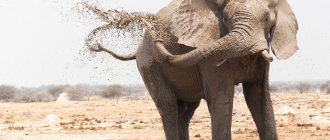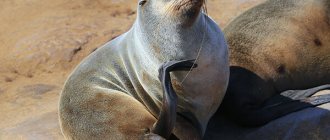You should know it
- International scientific name: Mirounga leonina.
- Conservation status: Least Concern.
- Characteristics: the body length of a large male sometimes reaches 5.5-6 m, weight - 3-4 tons. The fur of the elephant seal is hard, short, brownish-brown.
The southern elephant seal has a huge layer of subcutaneous fat, which is especially noticeable when the animal comes to land: its entire body shakes like frozen jelly.
Nutrition and behavior
Elephant seals are carnivorous mammals. Their diet includes squid, octopus, eels, fish, crustaceans, krill, and sometimes penguins. Males hunt on the ocean floor, while females hunt in the open ocean. Elephant seals use vision and the vibration of their whiskers to find food. They can attack sharks, killer whales and people.
These animals spend about 20% of their lives on land and about 80% in the ocean. Although they are aquatic animals, elephant seals are capable of outpacing humans on land. In the sea they reach a speed of 5-10 km/hour.
Elephant seals can dive to great depths. Males spend more time underwater than females. An adult male is capable of staying under water for about two hours and diving to a depth of about 2 km.
Organized rookeries
If you look at a photograph of an elephant seal rookery, you may get the impression of absolute chaos and lack of organization. However, this is not at all true. At the rookery, all animals take their places in accordance with a well-thought-out pattern. In a separate place there are females who will soon give birth. They appear at the rookery a month earlier than everyone else. Moreover, females are always located in a certain place. From time to time, the dominant male declares himself and his superiority with a loud roar, thereby scaring away unexpected guests. If his threats are not accepted and the other male does not want to leave someone else’s harem, the dominant male immediately rushes into a fight.
Offspring
The female southern elephant seal's pregnancy lasts about 11 months. After this period, between the end of September and mid-October, the cubs are born. The weight of a newborn is about 20-30 kg, body length is 80-100 cm. The mother feeds the baby with milk for the first three weeks of life. At this time, the cub must gain the maximum possible body weight. After finishing milk feeding, the baby separates from the mother and moves to the rookery of adult elephants. While there, he does not go into the water for some time and lives off the reserves of subcutaneous fat. At birth, the baby's body is covered with black fur, which falls out after three weeks. The small seal's fur becomes gray and remains that way for another year. By the age of three, little males begin to develop a trunk.
Elephant seal: description
Ancient fossils of these mammals were first discovered about a hundred years ago. Elephant seals got their name because of a special process that is located in the muzzle area, and is similar to the trunk of an elephant. It should be noted that such a process is the calling card of males, since females do not have such a process. On the nasal part of both males and females there are vibrissae, hypersensitive bristles.
Interesting to know! These animals molt in winter, and this process takes almost half a winter. At this time, elephant seals are on the shore. Their skin swells with many blisters, and the fur comes off in large volumes. From the outside, this process is not a very pleasant sight, and for animals it is a real discomfort.
The process for the animal is not only unpleasant, but also painful, which takes a lot of time. By the time new hair grows on the animal’s body, the animal significantly loses weight, acquiring an emaciated appearance. As soon as the molting process is over, elephant seals return to the water element to renew their strength and stock up on nutrients.
Elephant seals (lat. Mirounga)
Appearance
Elephant seals belong to the seal family and are the largest representatives. Since they live in both the Southern and Northern Hemispheres, they distinguish between southern and northern varieties. Species living in the Southern Hemisphere are characterized by slightly larger sizes compared to individuals whose habitat is associated with the Northern Hemisphere. Sexual dimorphism is very clearly expressed, since males are much larger compared to females. Adult males can weigh from 3 to 6 thousand kilograms, growing up to 5 meters in length. Females weigh no more than one thousand kilograms, growing no more than 3 meters in length. About 3 dozen species of pinniped mammals live on our Planet, with elephant seals considered the largest pinnipeds.
The main color of animals depends on factors such as gender and species, age of the animal, time of year, as well as natural living conditions. Depending on this, there are elephant seals whose coat color has reddish shades, light brown or light gray, as well as simply gray tones. Females are distinguished by a darker coat color, which has more earthy tones. Males have mostly mouse-colored fur. If you look at a herd of elephant seals basking in the sun on the shore, it looks as if there is a group of plush giants on the shore.
Elephant seals have a body shaped like an oval. Instead of paws, they have flippers, which allows them to quickly move through the water. The forelimbs are characterized by the presence of webbed toes armed with sharp claws. Their length can reach 5 centimeters. The elephant seal's limbs are so short that it has difficulty moving on land. They can move in increments of up to 35 centimeters maximum, especially since instead of hind limbs the animal essentially has a forked tail. The elephant seal's head is relatively small, blending smoothly into the body. The eyes are dark in color, in the shape of a flattened oval.
Character and lifestyle
Once on the shore, elephant seals turn into clumsy animals, but once in the water column, these animals turn into excellent swimmers, reaching speeds of up to 2 tens of kilometers per hour. Finding themselves in the water element, they prefer to lead a solitary lifestyle. They come ashore only during breeding periods, as well as during molting periods.
How long does an elephant seal live?
Elephant seals live from 20 to 22 years , northern elephant seals live about 9 years. In any case, the life expectancy of females is longer compared to males due to the fact that they are often injured in fights for the right to fertilize females.
Sexual dimorphism
Sexual dimorphism is especially pronounced in northern elephant seals, which is their peculiarity. Males are characterized by their significantly larger size, as well as the presence of a large trunk, like that of an elephant, which they use to intimidate their relatives when it is necessary to defend their rights. In addition, males differ from females in that they have many scars in the neck, chest, and shoulder girdle area, which were formed as a result of numerous bloody fights with other males during breeding periods.
As mentioned earlier, males have a trunk similar to that of an elephant, which is how the animal got its name. With the help of their trunk, males produce special vocal sounds that can be heard for many kilometers, especially during the breeding season. The functions of the trunk do not end there, since the trunk is capable of accumulating moisture, which is so necessary for males when they are on land during breeding periods.
The color of females is much darker, so they are mainly distinguished by a brownish color, with lightened areas in the neck area. These areas represent numerous bite marks left by males during the mating process. The body length of females is almost two times less than the body length of adult males, and the weight of females is almost 5 times less.
Species of elephant seals
There are both southern elephant seals, which are characterized by their enormous size, and northern elephant seals, which are somewhat smaller in size. They can be called marine inhabitants, but only partially, since their reproduction process takes place on land, as well as the molting process.
Where does the elephant seal live?
The habitat of northern elephant seals is associated with waters located near the territories of Canada and Mexico. Southern elephant seals prefer to live in waters located off the coast of New Zealand, off the coast of Africa and Argentina. Elephant seals appear on the shore in large groups to give birth to future offspring, as well as to renew their coat. It can happen at any time on any beach from Alaska to Mexico.
What do elephant seals eat?
Elephant seals are predatory marine creatures whose diet consists of cephalopods such as squid, octopus, eels, rays, seahorses, and various crustaceans. In addition, their diet includes fish, krill, and penguins.
Males prefer to hunt on the bottom, while females go to open waters. In search of food, these animals use their hypersensitive vibrissae, which react to the slightest fluctuations in water.
Elephant seals, in search of food, dive to significant depths, up to 2 thousand meters. As a rule, during these dives they hunt mainly for squid, as evidenced by many data obtained from studies of the stomachs of elephant seals. It should be noted that the menu contains fish and crustaceans.
After the breeding process, elephant seals prefer to go north to the shores of Alaska to replenish the body's lost nutrients. Diving to a depth of up to 2 thousand meters, elephant seals can hold their breath for two hours, although they generally dive for no more than 20 minutes. Basically, they are in the sea, constantly feeding, stocking up on fat and nutrients in order to once again appear on land, to prolong their genus, and also to acquire a new coat. During these periods of life, they cannot afford to be distracted by nutrition.
Elephant seals have a perfectly adapted body to dive to significant depths, holding their breath for two hours. They have special sinuses in the abdominal cavity in which oxygenated blood is stored. In addition, oxygen is stored in muscle tissue with myoglobin.
Reproduction and offspring
Despite the fact that in open waters elephant seals prefer to stay apart in order to give birth to a new generation, elephant seals appear on the shore, forming numerous groups. This happens every winter. Females can breed at the age of 3 to 6 years, and males at the age of 5-6 years. In fact, everything is much more complicated, since males who have reached this age do not always take part in the breeding process. The fact is that you will have to fight for the female, and for this you need to have a lot of strength. Only after 10 years of age will males gain enough kilograms and strength to become competitive in this fight. At this age, you can already become alpha males and acquire your own harem.
It is important to know! Males engage in fights, trying to use their body (mass), as well as their teeth, in the confrontation. Deaths are a fairly rare occurrence, but numerous bleeding wounds on the body are a common occurrence. In case of victory, the male can own a harem, numbering from 3 dozen to one hundred females.
The alpha male begins to push other males out of the colony, while some males manage to mate with some females. Despite the fact that the process of distribution of harems has already ended, the remaining males remain on land, defending their territories. As a result of such fights, females often die, as well as the offspring that are born. Males with their entire mass fall on their opponents, from which the individuals that are nearby are unprotected. The females suffer the most, as well as the newly born cubs.
The breeding process of northern elephant seals begins in December. The beginning of the process is characterized by the fact that males appear on the shore, after which females appear in order to form numerous harems. Each group of females has its own dominant male. Competition for a dominant position is quite high. Males try to establish their dominance in a certain territory through certain looks, through gestures, as well as through various sounds, which are amplified by the trunk. Each fight ends, although not in death, but in the presence of serious injuries inflicted by the fangs of the males.
After emerging on land, females give birth to their young within a few days, after which the female begins to feed her young with milk, the fat content of which is about 12 percent. After two weeks, the fat content of the milk is almost 50 percent. Milk during this period resembles a jelly-like mass. She feeds her offspring with this mass for 27 days, while she is not distracted by searching for food, relying only on her fat reserves. After the young become stronger and are ready for independent life, the female mates with the male and sets off for the open ocean.
Before setting off on their own, the offspring actively master the skills of swimming and diving in order to survive in open waters. Despite the presence of a fat reserve, which allows them to go without food for a long time, the mortality rate of young individuals is quite high. By approximately one year of age, up to 30 percent of the cubs die.
About half of the females, despite mating, do not bear offspring. A pregnant female carries her future offspring for 11 months, so females appear on the shore just before giving birth. As a result, only one cub is born. Feeding their offspring with milk for one month, the females do not eat anything, after which they mate again and go to the open ocean.
Natural enemies
Typically, the most vulnerable are baby elephant seals, which are susceptible to attacks by sharks and killer whales. Many cubs die as a result of fights between males on the shore.











